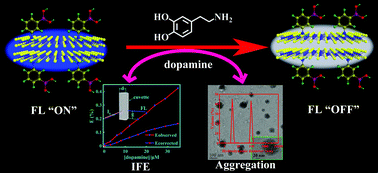Boronic acid-functionalized molybdenum disulfide quantum dots for the ultrasensitive analysis of dopamine based on synergistic quenching effects from IFE and aggregation†
Abstract
Herein, a novel fluorescent material, boronic acid-functionalized molybdenum disulfide quantum dots (B-MoS2 QDs) produced by an amidation reaction between 3-aminobenzeneboronic acid and previously prepared molybdenum disulfide quantum dots (MoS2 QDs), was prepared to fabricate a rapid and sensitive platform for the quantitative analysis of dopamine. This material exhibits strong fluorescence, excellent salt tolerance and light fastness. In particular, the quantum yield of this material is about 21.1 times that of its fundamental material, MoS2 QDs. Notably, owing to an interesting synergistic effect between the inner filter effect and the aggregation quenching effect, this material was successfully applied for the determination of dopamine in the linear range 0.25–35 μmol L−1 with the detection limit of 0.087 μmol L−1; moreover, B-MoS2 QDs manifested better selectivity in the presence of multiple interferences due to their inert surface. As expected, this proposed material shows satisfactory performance in human serum; thus, the present study exploits a new avenue for the application of functionalized MoS2 QDs in fluorescence sensing.



 Please wait while we load your content...
Please wait while we load your content...